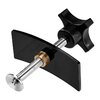Dunno...
since I'm starting a rebuild once I notice resistance upon pushing the pistons in by hand (like when removing the wheels...) I have no trouble of driving them out with my compressor's air-nozzle (the rubber tip seals perfectly on the banjo bore)...
I insert an assortment of 3 wooden strips to stop/balance the advancing pistons, last is like 3mm thick, from there I can remove them by hand...
Old bikes are tricky... a CX500 from the 80ies... garaged since the late 90ies...

I've an old front master with a short braided line here, clamped on a piece of steel tube, stationary in the bench vice, attach line, fill/bleed all with brake fluid, the wooden strips again, pump them pistons out, sometimes with a little aid from the heat gun... or zip-tie the handle and let sit for some time, or over night...
And there pliers avail, use with care to not deform the pistons:
Rinse all in the parts cleaner, detail & brush with automotive wheel cleaner (the one with the stench of sulfuric acid, rinse with lots of warm water when its turning purple), blow everything dry, a set of workshop picks, an occasional blow with the heat gun to soften them crystals, an ultrasonic dental pick and some nylon wheels in the Dr.Emel tool to clean those grooves...
As final step I throw all items into the ultrasonic cleaner, don't exceed 60°C/140°F as the paint might suffer... retrieve from the bath, dry with compressed air while still hot...
Pistons with pitting, scratches or discolored/scraped galvanization get replaced... OEM, or stainless if avail...
No steel wool, only ferro-free abrasion fleece (the stuff you clean copper pipes prior brazing)...
For putting things together I use designated ATE brake assembly paste, viscosity like silicone grease, but brake fluid compatible...
Takes some time though, so good tunes and some coffee sweeten the job...


